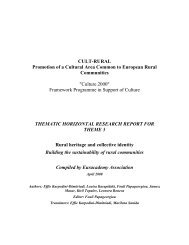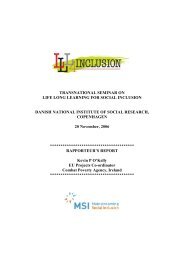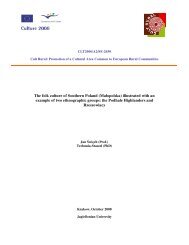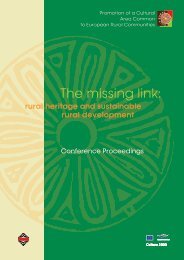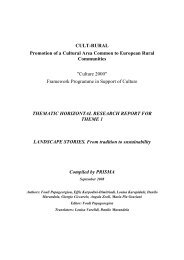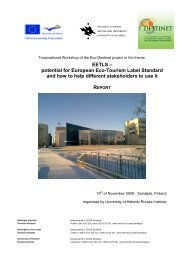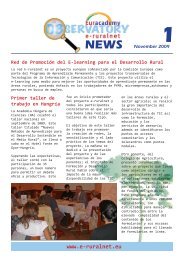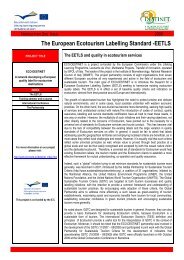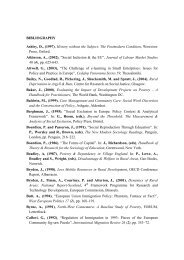ÐÐ¾Ð´Ð°Ñ Ð¿Ð¾ изложбаÑа - cult rural - Prisma
ÐÐ¾Ð´Ð°Ñ Ð¿Ð¾ изложбаÑа - cult rural - Prisma
ÐÐ¾Ð´Ð°Ñ Ð¿Ð¾ изложбаÑа - cult rural - Prisma
You also want an ePaper? Increase the reach of your titles
YUMPU automatically turns print PDFs into web optimized ePapers that Google loves.
RITES OF PASSAGE<br />
In Sarakatsanis’ villages the Flambouro was made on the Friday before the<br />
wedding either by a young unmarried boy or by the groom’s mother. With a cross<br />
on it, a symbol of faith, it was decorated with many other fertility and prosperity<br />
symbols - coins, apples, gold or coloured ribbons or threads, chains, etc. In some<br />
Sarakatsani areas they prepared three Flamboura with stitched wooden pompons<br />
(kiritsia) fl ower shaped and with bells on their centre, symbols of fertility and<br />
apotropaic. Coloured pompons also decorated the bundle of woods to be used<br />
for the cooking of bread and food of the wedding ceremony. The pompons will be<br />
offered later on by the groom’s mother to the women taking part in the wedding<br />
preparation. She also gave them kerchiefs, which were used to lead the dances.<br />
The wedding ceremony, with a few exceptions, takes place in the church. Once it<br />
is completed the newly weds are walked to their house accompanied by friends<br />
and relatives. In front of their future house the groom’s mother will receive the<br />
bride and welcome her by offering honey, sweets or nuts. In some places they<br />
also offered a glass of water or bread while a pomegranate was given to the bride<br />
to throw it in the courtyard in order to secure prosperity. The wedding feast takes<br />
place right after the bride’s reception with drinking and folk dancing.<br />
In Poland, celebrating marriage is connected to a set of customs and rites<br />
shaped by tradition. At this important and symbolic moment of transition, change<br />
of family and social status, the wedding rites are intended to secure good luck to<br />
the bride and groom.<br />
Wedding ceremonies lasted from a few days to a week and they were held at<br />
the time of “zapusty” or in autumn after the harvest. In the territory of Małopolska<br />
after recognizing the possibility of solemnizing marriage (the so-called “zwiady”),<br />
matchmaking (“zmówiny”) took place, and later “zrękowiny” comprising elements<br />
of old property contracts. The initial consent to solemnize a marriage, agreeing<br />
on a dowry completed by the ritual of drinking vodka and paying for announcing<br />
the wedding in church, meant the beginning of preparations for the wedding. A<br />
host and a hostess (“swaszka”) were chosen, as were best men, wedding clothes<br />
were made, food and drinks were gathered and guests invited.<br />
In the Rzeszów region the wedding was preceded by a party at swaszka’s (the<br />
so-called “swaszczyny”). The wedding ceremony was started by “zrękowiny”<br />
in the morning, and after the parents’ blessing the wedding procession moved<br />
towards the church, and then to the bride’s house, where the wedding reception<br />
and the party with musicians had been prepared. In the meantime, another<br />
wedding procession had to overcome colourfully decorated barriers – to cross<br />
which it had to pay with vodka and sweets. The most important wedding rite<br />
was “oczepiny” symbolizing the transition from maiden status to the circle of<br />
married women. It was performed by the ritual of taking the wreath off the bride’s<br />
head and putting on it a bonnet. On completion of the wedding there was a rite<br />
of moving the bride to her husband’s house together with the dowry kept in a<br />
wooden, colourfully polychrome chest.<br />
The wedding rites were accompanied by numerous inevitable items. They<br />
were: a wedding “rózga” (“wiecha”) – the symbol of the bride’s maidenhood. It<br />
was made the day before the wedding and it was used for wedding rites until<br />
75. Wedding cake. Neighbourhood of Rzeszów,<br />
Podkarpackie voivodship, Poland (ME in Rzeszów)<br />
76. Dowry chest. Łukawiec, Podkarpackie<br />
voivodship, 1896, Poland (MK in Lubaczów)<br />
40<br />
75. 76. 77.<br />
77. Wedding „wiecha”. Kolbuszowa, Podkarpackie<br />
voivodship, 2007, Poland (ME in Rzeszów)<br />
78. Parents welcome the bride and groom.<br />
Podhale, Małopolskie voivodship, phot J.<br />
Baranowski, 1955, Poland (ME in Cracow)




